Related Research Articles

The Shaddadids were a Kurdish Sunni Muslim dynasty who ruled in various parts of Armenia and Arran from 951 to 1199 AD. They were established in Dvin. Through their long tenure in Armenia, they often intermarried with the Bagratuni royal family of Armenia.

Simon I the Great also known as Svimon (1537–1611), of the Bagrationi dynasty, was a Georgian king of Kartli from 1556 to 1569 and again from 1578 to 1599. His first tenure was marked by war against the Persian domination of Georgia. In 1569 he was captured by the Persians, and spent nine years in captivity. In 1578 he was released and reinstalled in Kartli. During this period, he fought as a Persian subject against the Ottoman domination of Georgia. In 1599 Simon I was captured by the Ottomans and died in captivity. During 1557 to 1569 he was known as Mahmud Khan and from 1578 to 1599 as Shahnavaz Khan

Rawwadid or Ravvadid or Banū Rawwād (955–1071), was a Muslim ruling family centered in historic Azerbaijan between the late 8th and early 13th centuries.
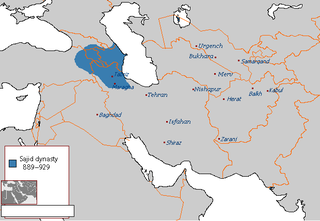
The Sajid dynasty, was an Iranian Muslim dynasty that ruled from 889-890 until 929. The Sajids ruled Azerbaijan and parts of Armenia first from Maragha and Barda and then from Ardabil. The Sajids originated from the Central Asian province of Ushrusana and were of Iranian (Sogdian) descent. Muhammad ibn Abi'l-Saj Diwdad the son of Diwdad, the first Sajid ruler of Azerbaijan, was appointed as its ruler in 889 or 890. Muhammad's father Abu'l-Saj Devdad had fought under the Ushrusanan prince Afshin Khaydar during the latter's final campaign against the rebel Babak Khorramdin in Azerbaijan, and later served the caliphs. Toward the end of the 9th century, as the central authority of the Abbasid Caliphate weakened, Muhammad was able to form a virtually independent state. Much of the Sajids' energies were spent in attempting to take control of neighboring Armenia. The dynasty ended with the death of Abu'l-Musafir al-Fath in 929.

Yusuf ibn Abi'l Saj was the Sajid amir of Azerbaijan from 901 until his death. He was the son of Abi'l-Saj Devdad.

Abu'l-Aswar or Abu'l-Asvar Shavur ibn Fadl ibn Muhammad ibn Shaddad was a member of the Shaddadid dynasty. Between 1049 and 1067 he was the eighth Shaddadid ruler of Arran from Ganja. Prior to that, he ruled the city of Dvin from 1022 as an autonomous lord. A capable warrior, and a wise and cunning ruler, Abu'l-Aswar was engaged in several conflicts with most of his neighbours. During his rule over Dvin, he was mostly involved in the affairs of the Armenian principalities. He collaborated with the Byzantine Empire in its conquest of the last remnants of Bagratid Armenia in 1045, but when the Byzantines later turned on him, he survived three successive offensives that sought to take Ganja. In 1049, a revolt in Ganja overthrew his infant great-great-nephew, Anurshirvan. The rebels invited him to take up the family's emirate, and he moved from Dvin to Ganja. Under his rule, the Shaddadid dynasty reached its zenith. He undertook successful campaigns into Georgia and Shirvan, although the limits of Shaddadid power were exposed by his failure to take over the Emirate of Tiflis and by devastating raids by the Alans. At the same time, his reign witnessed the rapid rise of the Seljuk Empire and the extension of its control over the Transcaucasian principalities. Abu'l-Aswar became a Seljuk vassal in 1054/5. Although he gained control over the former Armenian capital of Ani through Seljuk patronage in 1065, this association also paved the way for the dynasty's decline after his death in November 1067.
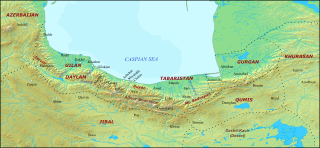
Tabaristan or Tabarestan, was the name applied to a mountainous region located in the Caspian coast of northern Iran. It corresponded to the present-day province of Mazandaran, which became the predominant name of the area from the 11th-century onwards.
Kvirike I was a Prince and Chorepiscopus of Kakheti in eastern Georgia from 893 to 918.
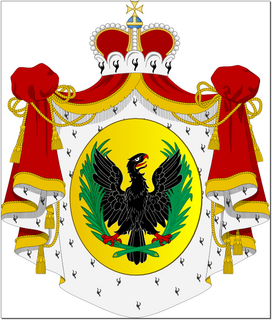
The Avalishvili is a Georgian noble family, which branched off the Panaskerteli-Tsitsishvili house in the 16th century. The initial appanage of the family was located in the historical area called Tori and now known as the Borjomi Gorge with its center at the village of Sadgeri. From 1545 onward, they were vassals to the princes of Samtskhe, which soon came under the influence of the Ottoman Empire and Islam. Fleeing the Islamization of the area, several members of the Avalishvili family moved into inner Georgia early in the 17th century; those who remained in their patrimonial fiefdom, became Muslim and received the title of bek. A branch in Imereti, western Georgia, soon went into decline and their status was downgraded to that of petty nobility. The refugees to the eastern Georgian lands – Kartli and Kakheti – were enfeoffed with several estates and were reconfirmed, in 1826 and 1850, as princes of the Russian Empire.

Georgia, a Christian kingdom in the Caucasus, was subjected, between 1386 and 1403, to several disastrous invasions by the armies of Turco-Mongol conqueror Timur, whose vast empire stretched, at its greatest extent, from Central Asia into Anatolia. These conflicts were intimately linked with the wars between Timur (Tamerlane) and Tokhtamysh, the last khan of the Golden Horde and Timur's major rival for control over the Islamic world. Timur officially proclaimed his invasions to be jihad against the region's non-Muslims. Although he was able to invade parts of Georgia, he was never able to make the country Muslim and even recognized Georgia as a Christian state.

Gobron also known as Mikel-Gobron or Michael-Gobron (მიქელ-გობრონი) was a Christian Georgian military commander who led the defense of the fortress of Q'ueli against the Sajid emir of Azerbaijan. When the fortress fell after a 28-day-long siege, Gobron was captured and beheaded, having rejected inducements to convert to Islam. Shortly after his death Gobron became the subject of the hagiography authored by Bishop Stephen of T'beti and a saint of the Georgian Orthodox Church, which commemorates him on November 30. His martyrdom is also mentioned by the medieval Georgian and Armenian chronicles.
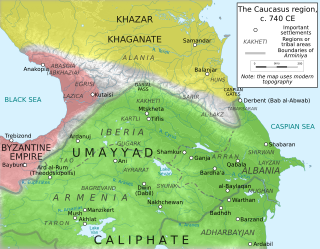
Marwan ibn Muhammad's invasion of Georgia took place from 735 to 737. It was initiated by the Umayyad Caliphate. The goals of the campaign are disputed among historians. The Georgian historiography insists its main purpose was to finally break the stiff Georgian resistance against Arab rule, however, the western historians such as Cyril Toumanoff, and Ronald Suny, view it as a general campaign directed at both the Byzantine Empire, who exerted dominion over Western Georgia, and the Khazars, whose repeated raids affected not only Iberia and the whole Caucasus, but had in 730 reached Arab lands all the way to Mosul.
Leon I of Abkhazia, hereditary prince (Eristavi) of Abkhazia, ruling between 720–740 and a vassal to the Byzantine Emperor. The Divan of the Abkhazian Kings mentions that his reign took place in the 1st half of the 8th century. During his reign Leon actively battled invading Arabs and had close diplomatic contacts with the prince of Iberia and Kakheti, Archil. He also had significant relations to the Byzantine emperor Leo III the Isaurian, to whom he sent a letter asking for help against the forces of the Umayyad Caliphate. In answer, the Emperor confirmed his hereditary rule over the Kingdom of Abkhazia and suggested that he should accept Archil as his overlord and suzerain and by doing so, battle the Muslims with united forces. Leo III also bestowed the title of Archon upon the Abkhazian King. This meant that the Byzantines accepted Leon I's rule over the lands of Egrisi, Jiketi and Sanigia. The ties between Archil and Leon I were also strengthened by Leon's marriage with Gurandukht, the daughter of Archil's brother Mirian of Kakheti.
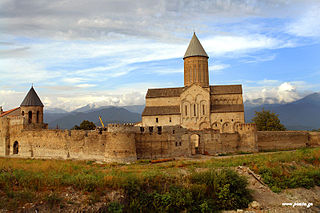
The Bakhtrioni uprising was a general revolt in the eastern Georgian Kingdom of Kakheti against the political domination of Safavid Persia, in 1659. It is named after the main battle, which took place at the fortress of Bakhtrioni.

Arab rule in Georgia refers to the period in the History of Georgia when all or part of the country was under political domination of Muslim Arab rulers, from the first Arab incursions in the mid-7th century until the final defeat of the Emirate of Tbilisi at the hands of King David IV in 1122. This period is called Araboba (არაბობა) in Georgian. Compared with other regions which endured Muslim conquests, Georgia's culture, and even political structure was not much affected by the Arab presence, as the people kept their faith, the nobles their fiefdoms, and the foreign rulers mostly insisted on the payment of tribute, which they could not always enforce. Still, repeated invasions and military campaigns by the Arabs devastated Georgia on many occasions, and the Caliphs retained suzerainty over large parts of the country and exerted influence over the internal power dynamics during most of the period.

The Siege of Q'veli or Siege of Q'ueli was the last major military engagement during the Sajid invasion of Georgia in 914. The heroic 28-day long siege resulted in pyrrhic Muslim victory and execution of the Georgian commander Gobron. Despite the important victory, the invaders were unable to maintain a strong foothold in western Georgia and were forced to withdraw.
Muflih al-Saji was a Muslim commander and governor of Adharbayjan from c. 929 to c. 935.
The Kingdom of Kakheti-Hereti or just the First Kingdom of Kakheti was an early Medieval monarchy in eastern Georgia, centered at the province of Kakheti, with its capital first at Telavi. It emerged in c. 1014 AD, under the leadership of energetic ruler of principality of Kakheti, Kvirike III the Great that finally defeated the ruler of Hereti and crowned himself as a king of the unified realms of Kakheti and Hereti. From this time on, until 1104, the kingdom was an independent and separated state from the united Kingdom of Georgia. The kingdom included territories from riv. Ksani to Alijanchay river and from Didoeti to southwards along the river of Mtkvari.
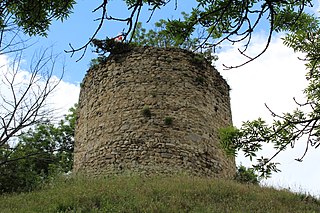
The Bochorma fortress is a medieval architectural complex in eastern Georgia, located in the Tianeti Municipality in the region of Kakheti. Situated on a high mount on the Iori River, the complex consists of a castle and a domed dodecagonal church, both dated to the 10th century, as well as another small hall church, and some other accessory structures. All structures within the complex are half-ruined or significantly damaged. They are all inscribed on the list of the Immovable Cultural Monuments of National Significance.
In the history of Azerbaijan, the Early Middle Ages lasted from the 3rd century to the 11th century. This period in the territories of today's Azerbaijan Republic begins with the incorporation of these territories into the Sasanian Persian Empire in the 3rd century AD. Feudalism started to shape in Azerbaijan in the Early Middle Ages. The territories of Caucasian Albania became an arena of wars between the Byzantine Empire and the Sassanid Empire. After the fall of the Sassanid Empire by the Arab Caliphate, Albania also weakened, and in 705 AD it was overthrown by the Abbasid Caliphate under the name of Arran. As the control of the Arab Caliphate over the Caucasus region weakened, independent states began to emerge in the territory of Azerbaijan.
References
- ლორთქიფანიძე მ., სომეხი და ქართველი ხალხების ბრძოლა არაბთა ბატონობის წინააღმდეგ, «ივ. ჯავახიშვილის სახ. ისტორიის ინსტიტუტის შრომები», ტ. 4, ნაკვ. 1, თბ., 1958;
- ჯავახიშვილი ივ., ქართველი ერის ისტორია, წგნ. 2, თბ., 1965;
- ლორთქიფანიძე მ., ქსე, ტ. 1, გვ. 45-46, თბ., 1975
- Minorsky, Vladimir; Bosworth, Clifford Edmund (1986). "al-Kurd̲j̲". In Bearman, P.; Bianquis, Th.; Bosworth, C.E.; Donzel, E. van; Heinrichs, W.P. (eds.). Encyclopaedia of Islam (2nd ed.). Leiden: Brill. pp. 487–497. ISBN 9004078193.
| | This Georgia-related article is a stub. You can help Wikipedia by expanding it. |